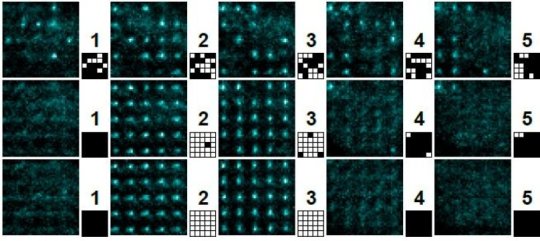[ad_1]
Reduced entropy in a three-dimensional lattice of super-cooled, laser-trapped atoms could help speed progress toward creating quantum computers. A team of researchers at Penn State can rearrange a randomly distributed array of atoms into neatly organized blocks, thus performing the function of a “Maxwell’s demon” — a thought experiment from the 1870s that challenged the second law of thermodynamics. The organized blocks of atoms could form the basis for a quantum computer that uses uncharged atoms to encode data and perform calculations. A paper describing the research appears September 6, 2018 in the journal Nature.
“Traditional computers use transistors to encode data as bits that can be in one of two states — zero or one,” said David Weiss, professor of physics at Penn State and the leader of the research team. “We are devising quantum computers that use atoms as ‘quantum bits’ or ‘qubits’ that can encode data based on quantum mechanical phenomena that allow them to be in multiple states simultaneously. Organizing the atoms into a packed 3D grid allows us to fit a lot of atoms into a small area and makes computation easier and more efficient.”
The second law of thermodynamics states that the entropy — sometimes thought of as disorder — of a system cannot decrease over time. One of the consequences of this law is that it precludes the possibility of a perpetual motion device. Around 1870, James Clerk Maxwell proposed a thought experiment in which a demon could open and close a gate between two chambers of gas, allowing warmer atoms to pass in one direction and cooler atoms to pass in the other. This sorting, which required no energy input, would result in a reduction of entropy in the system and a temperature difference between the two chambers that could be used as a heat pump to perform work, thus violating the second law.
“Later work has shown that the demon doesn’t actually violate the second law and subsequently there have been many attempts to devise experimental systems that behave like the demon,” said Weiss. “There have been some successes at very small scales, but we’ve created a system in which we can manipulate a large number of atoms, organizing them in a way that reduces the system’s entropy, just like the demon.”
The researchers use lasers to trap and cool atoms in a three-dimensional lattice with 125 positions arranged as a 5 by 5 by 5 cube. They then randomly fill about half of the positions in the lattice with atoms. By adjusting the polarization of the laser traps, the researchers can move atoms individually or in groups, reorganizing the randomly distributed atoms to fully fill either 5 by 5 by 2 or 4 by 4 by 3 subsets of the lattice.
“Because the atoms are cooled to almost as low a temperature as possible, the entropy of the system is almost entirely defined by the random configuration of the atoms within the lattice,” said Weiss. “In systems where the atoms are not super-cooled, the vibration of the atoms makes up the majority of the system’s entropy. In such a system, organizing the atoms does little to change the entropy, but in our experiment, we show that organizing the atoms lowers the entropy within the system by a factor of about 2.4.”
In addition to Weiss, the research team at Penn State includes Aishwarya Kumar, Tsung-Yao Wu, and Felipe Giraldo Mejia. The research was funded by the U.S. National Science Foundation.
Story Source:
Materials provided by Penn State. Original written by Sam Sholtis. Note: Content may be edited for style and length.
[ad_2]















